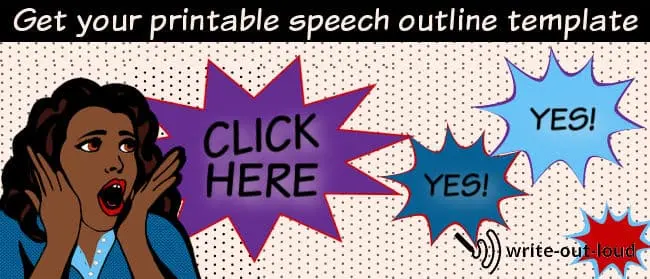- HOME ›
- How to write a speech ›
- How to outline a speech
Sample speech outline template
Get a printable. Learn how to outline a speech effectively.
By: Susan Dugdale
There's a printable sample speech outline template below for you to download, and use.
Why? Because a well-completed outline becomes the backbone of your speech. You'll use it to guide you logically, and carefully, through ALL the aspects you need to consider before you actually write the speech itself.
It will help you clarify what material you want to cover to fit your audience, and speech purpose, as well as help to effectively organize it.
What you'll find on this page:
- the reasons for using a speech outline
- how to outline a speech: the 4 essentials steps involved in writing an outline - detailed sequential help, with examples, covering:
1. choosing a topic,
2. audience analysis,
3. choosing the best organizational pattern to fit your speech purpose,
4. what to put in each part of your speech: introduction, body and conclusion
- a printable speech outline template to download
- links to 2 completed examples of speech outlines (a demonstration and a persuasive speech. Both with printable outlines to download.)
- a link to 7 completed examples of impromptu speech outlines, each with printable speech outline templates
- links to more resources for preparing an effective speech
Why bother writing a speech outline?
Because completing a speech outline is the first vital step toward preparing a successful speech.

It is often overlooked in a misguided attempt to get on with what is considered the real work: writing the speech, or the words you're going to say.
Despite what many people think, time spent completing an outline is not wasted. Instead, it helps you save it. And sidestep any anxiety caused by inadequate preparation.
The process might appear daunting and horrifically time consuming but prepare a speech outline all the same.☺
What you'll learn about speech structure, matching content to your speech purpose and your audience's needs will pay you back over and over again. I promise you, having an outline will make giving a speech easier and less stressful.
How to best use this page
Read the page all the way through to familiarize yourself with the terms and the process. When you're done, click the link at the foot of the page to download and print the blank sample speech outline template for your own use.
How to outline a speech: 4 essential steps
The process of outlining a speech is broken down into 4 essential steps.
(Click a heading to find out more about each one)
- Preparation-
- deciding on your topic
- considering the audience and refining your topic to suit them
- deciding on the purpose of the speech
- choosing an organizational method to support your speech purpose
- Introduction-
- opening greeting and attention getter
- defining your thesis statement (a summary of what your speech is about)
- establishing your credibility
- an overview and the benefit to the audience
- Body-
- transition or link between introduction and body
- main ideas with supporting ideas
- examples and details
- Conclusion-
- summary of main points
- closer or call to action
Remember this old saying?
First: tell them what you're going to tell them.
Second: tell them.
Third: tell them what you told them.
A simple, or basic, speech outline follows that advice.
- 'Tell them what you're going to tell them' becomes your introduction
- 'Tell them' forms the body
- 'Tell them what you told them' is your conclusion
Step 1 - Preparation for writing a speech outline
You need to complete this step before you do anything else. It is made up of five smaller steps, each of them an important part of the overall process. The decisions you make at this point will have a major impact on the final outcome of your speech.
By the time you are finished step 1 you will have:
- decided on your topic
- analyzed your audience
- refined your topic to meet the needs of your audience
- decided on the specific purpose of your speech
- chosen the best fitting of six organizational patterns to use - one matching your purpose and your material
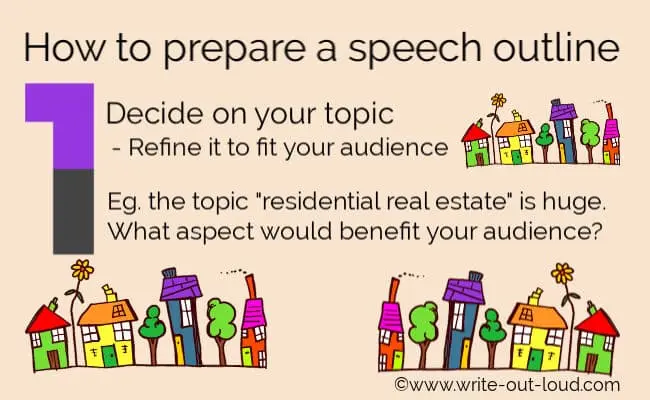
Start with choosing a topic
The place to begin is deciding what you are going to talk about.
For example, if you are a realtor (real estate agent) who has been asked to talk to a suburban community group residential real estate seems like a good logical topic to pick.
(If you don't have a topic in mind, go to speech topics. You'll find 100s of them ordered by speech type and theme.)
Put yourself to one side & focus on your audience
However, before you make a final decision considering more closely who will be listening to you makes better sense than assuming whatever you come up with will be right!
How do you really know what aspects of your topic are best suited to meet your audience's needs? Or what would be of real benefit for them to hear about?
The scope of the topic 'residential real estate' is huge.
Your speech could cover any number of sub-topics like: financial advice for first home buyers, how to thoroughly check a house before purchase, the rise of mortgagee default sales, the collapse of property development schemes, how to purchase properties for makeovers...
Analyze your audience
So before you settle on the exact topic of your speech analyze your audience.
Without analysis you are 'guessing' what would be interesting and relevant for them to hear.
Refine your topic
Using what you found out about your audience, decide on an aspect of your topic that will be of benefit to them and the angle you will take on it. Take care with this. One size does not fit all!
For example a speech on housing affordability which includes a step by step plan toward buying a first home will likely interest an audience of youngish, (late 20s- early 40s), people with steady professional incomes.
But for another audience, (e.g. one that is older, less financially secure, or younger and not ready to consider settling yet...), it could be completely inappropriate.
Minimize the risk of getting it wrong by finding out as much as you can about your audience.
Deciding on the purpose of your speech
What is the purpose of this speech? Why are you giving it?
Is it to persuade or inform? Is it to demonstrate, entertain, or welcome? Or is it a combination of these?
What do you want your speech to achieve?
Is there a particular action you want people to take as a result of listening to you?
Your answers to all of these questions will dictate what organizational pattern you'll use for your speech, its content and tone.
Choosing an organizational pattern or method
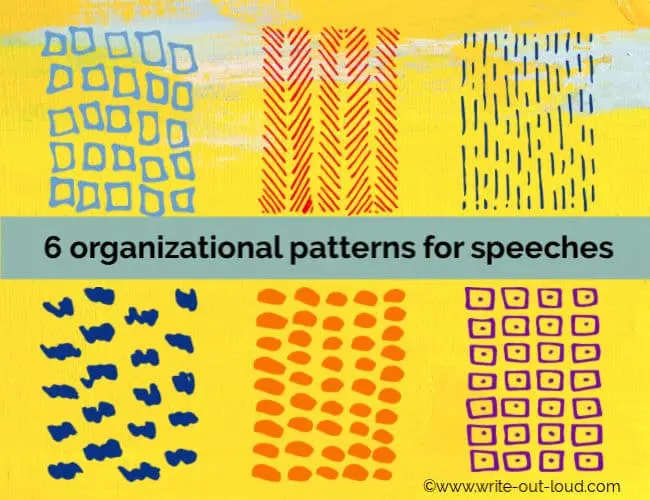
There are 6 basic organizational patterns or methods of arranging the body (main points) of your material. Choose the one most appropriate for your need.
1. Cause - Effect
Because event 'A' happened, event 'B' occurred.
Examples:
- Because the driver was speeding, they crashed the car.
- Because of the earthquake, the city was destroyed.
- Because the minimum wage is low, families can not afford good health care.
2. Problem - Solution
The problem is 'X'. The answer is 'Y'.
Examples:
- The problem is unaffordable housing. The solution is community funded housing complexes.
- The problem is unemployment. The solution is meaningful, sustainable education and employment programs.
- The problem is poor food choices. The solution is practical community outreach programs to teach people about nutrition, food buying, storage and preparation, along side living wages, educational and employment programs.
3. Logical
This pattern suits a broad topic which can be broken down into naturally occurring sub-topics.
Examples:
- The broad topic is 'Vocal Variety'. Its sub-topics include rate of speech, use of pausing, voice tone, volume, articulation...
- The broad topic is 'Organizational speech patterns'. Sub-topics could be problem-solution, cause- effect, logical...
- The broad topic is 'Residential real estate'. Its sub-topics could include houses for first-home buyers, how to apply for a mortgage, how to select the right neighborhood to buy in, the impact of high-density housing...
4. Spatial or geographic
Use this pattern for topics dealing with physical spaces.
Examples:
- The 10 most popular tourist attractions in New Zealand.
- The European migration patterns of the 19th century.
- The population shift from country to town in USA.
5. Time or chronological/sequential
These are either historical topics or demonstration speeches. The foundation of both is an ordered sequence of events.
For example:
- The history of women's suffrage in USA, the abolition of slavery
- How to bake a cake, how to mend a puncture in a bicycle tire, or how to knot a tie
6. Advantage - disadvantage
Use this pattern to examine the range of positive and negative aspects of an idea or event.
For example:
- What are the advantages and disadvantages of private schooling?
- What are the advantages and disadvantages of lowering the voting age?
- What is good about supporting local industry? What is negative about supporting local industry?
Step Two - Outlining the introduction
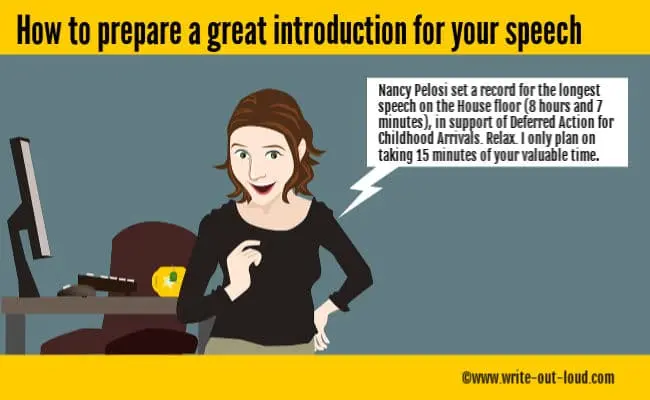
The 5 parts of preparing an introduction
1. Greeting & attention getter
How are you going to greet your audience, grab their attention and compel them to listen?
You could use a rhetorical question, a startling statistic, a quotation or a humorous one-liner. To be effective it must be related to your topic and apt for your audience.
Examples:
- Rhetorical question
How many of you really are more afraid of public speaking than death? - A startling statistic
Apparently in USA 75% of the population experiences public speaking anxiety. Some just a little. And some a lot. - A quotation
Mark Twain famously said, there are only two types of speakers in the world: the nervous and the liars. - Humorous
Speaker of United States House of Representatives, Nancy Pelosi set a record for the longest speech on the House floor: 8 hours and 7 minutes. Relax. I only plan on taking 15 minutes of your valuable time.*
*Be careful with humor. It will only work if it's appropriate; that is fitting for the occasion, and understood by the majority of your audience. For more about Nancy's record: Nancy Pelosi's all-day marathon speech sets record as longest continuous speech since at least 1909.
For more on effective speech openings see: How to write a speech introduction - 12 of the best ways to start a speech
2. Thesis statement
This is a short summary of your speech topic and your point of view or angle.
Example:
Green politics is no longer a fanciful fringe fad. It is a necessity.
3. Credibility
This segment establishes your right to speak on the topic. It cites your qualification or expertise.
Using myself as an example, I can speak about preparing speeches because I've written many over the past twenty or so years. Prior to becoming a professional speech writer, I taught high school level English and drama and I also belonged to the global public speaking club Toastmasters for a long time.
4. Summative overview
This is a brief outline of the main points you are going to cover.
Example:
Today I am going to share with you three effective ways to lessen public speaking fear.
The first and second cover aspects of preparation: writing and rehearsal or practice: actually doing the work, rather than being frightened of it. ☺ The third is about the benefits of public speaking.
5. Benefit(s)
What's in your speech for your audience? Why will they want to hear what you've got to tell them? Be specific. Tell them.
Example:
When you make a decision to speak up in public you also gain: confidence, the ability to take on leadership roles, a growing collection of presentation skills like story telling, how to use your voice, the ability to use props well, how to listen, how to craft a speech to meet the needs of specific audiences... In short, you release the potential to become a bigger and better you*.
(* For more see 14 benefits of public speaking.)
Step Three - Outlining the body of your speech
This is the heart of your speech, the place where you lay out what you want to share with your audience.
Generally three main ideas, along with supporting examples, work more effectively than four or five or more. If you have a number of them to choose from, go with your three strongest points. And if one of your final three is noticeably weaker sandwich it between the other two.
If you intend to use visual aids (slides showing graphs, tables or images), or actual props, mark them in too.
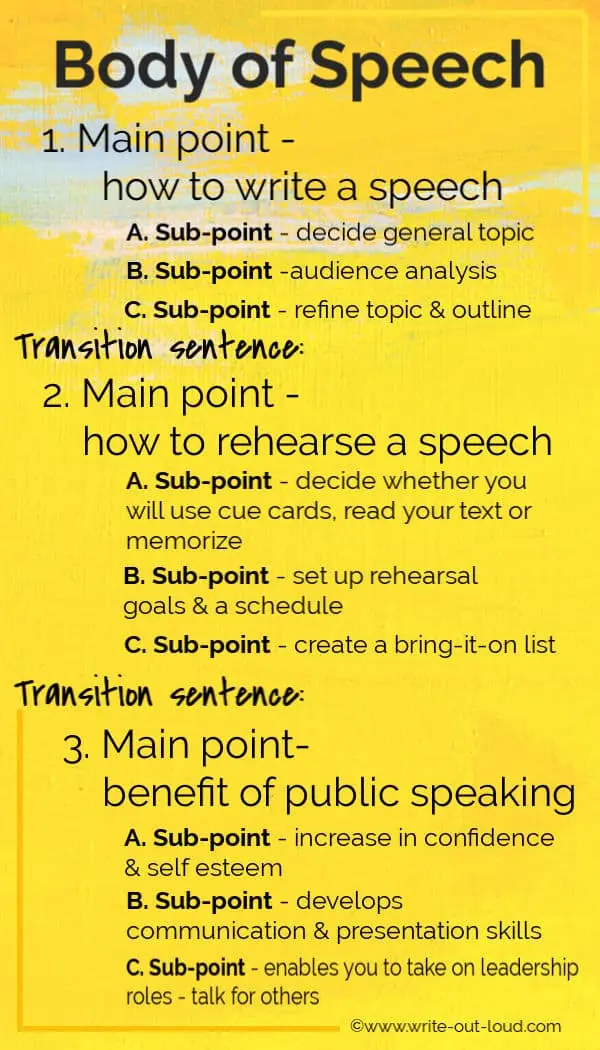
- Transition
This is the link between your introduction and the main body of your speech. How will you tie them together?Note: If you're unsure about the exact nature of links or transitions and how they work or what they are, you'll find more about them, with examples, on my page how to write a speech
- Main Idea 1 - Supporting ideas - Details and examples - Visuals or props - Transition to...
- Main Idea 2 - Supporting ideas - Details and examples - Visuals or props - Transition to...
- Main Idea 3 - Supporting ideas - Details and examples - Visuals or props - Transition to...
Step Four - Outlining the conclusion of your speech
There are four parts to preparing an effective conclusion to your speech. Use them to draw together and summarize all the material from your introduction and the body of your speech, and end with a clincher!

- Summary of main ideas
These are the main points you covered in the body of your speech. - Re-statement of thesis statement
Use the statement from your introduction to reinforce your message. - Re-statement of benefit to audience
Remind the audience of the benefits they'll receive through carrying out whatever your propose. Again this comes from your introduction. - Closer, Clincher or Call to Action
This is your final sentence. To ensure your speech ends with a bang rather than a whimper check out this page on how to end a speech memorably. You'll find options and examples.
Get your printable sample speech outline template
This is a simple four page PDF of all four steps and their sub- headings with spaces for you to write your notes. Click to download and print your sample speech outline now.
2 completed examples of speech outlines
Use these links to go to a fully completed:
- demonstration speech outline example on how to leave an effective voice mail message (with a free printable sequential demonstration speech outline template)
- persuasive speech topic outline example on overcoming public speaking fear using Monroe's Motivated Sequence (with a free printable MMS persuasive speech outline template)
Example impromptu speech outline patterns
Impromptu speech outline patterns - seven different structural formats, each with completed examples and a free blank printable outline for you to download and use.
Other resources for preparing successful speeches
Planning and writing
This page goes into more detail (with examples) about planning a speech and this one provides step by step examples on how to write a speech.
Rehearsing a speech
Once you're done with planning, completing your sample speech outline and writing find out how to rehearse. A speech is a live performance. Rehearsal helps you expose and iron out glitches before you find them out the hard way - in front of your audience.
Speech evaluation
And if your speech is being assessed check out this standard speech evaluation form to see what aspects are likely to be judged and how a rating scale works.

About the Author: Susan Dugdale, founder of write-out-loud.com, is a qualified teacher of English and drama with over 40 years of experience. Drawing on her professional expertise and her personal journey from shyness to confidence, Susan creates practical, real-world resources to help people find their voice and speak with power.
